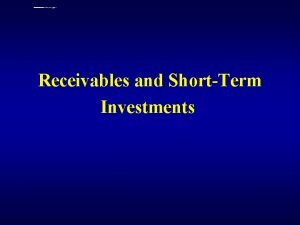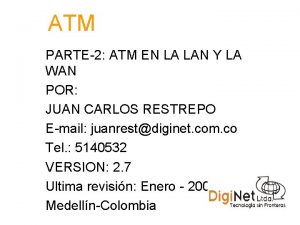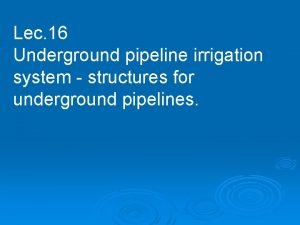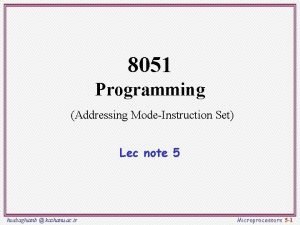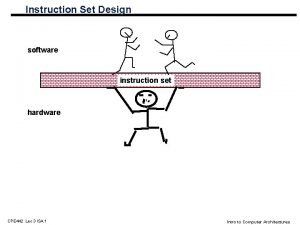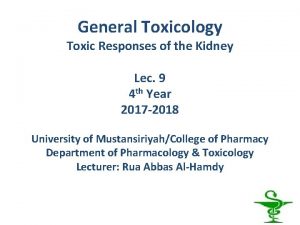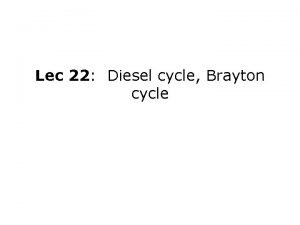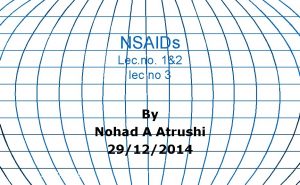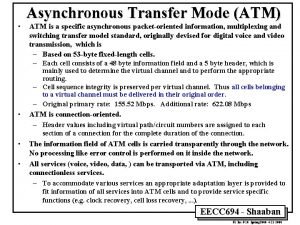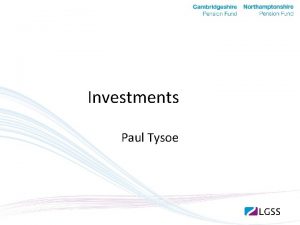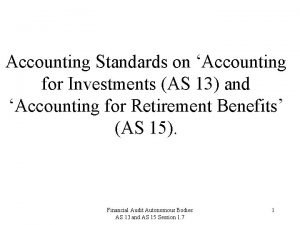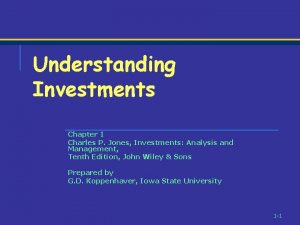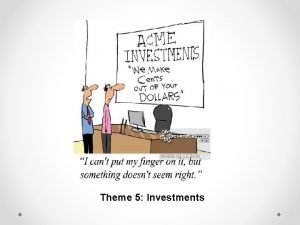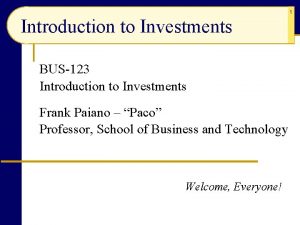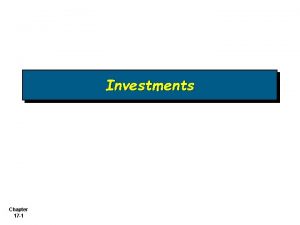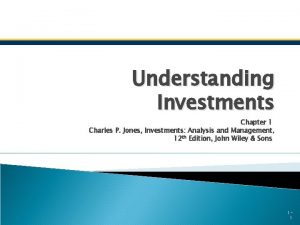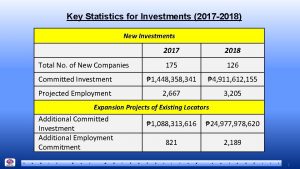LECTURE 31 Lec 30 Accounting for Investments LECTURE

















































































- Slides: 81


LECTURE 31 Lec. 30 Accounting for Investments

LECTURE 31: BUDGET, CAPITAL BUDGET

LECTURE 31: BUDGET, CAPITAL BUDGET

Summary of Lec 30

Learning Objectives of Lecture - 30 1. Meaning of fixed income securities classified as “held-to-maturity” 2. Accounting for held-to-maturity securities in the light of relevant accounting standards 3. Classification of investments from intention and other perspectives 4. Effective interest and amortized cost measurement concepts Lec. 30 Accounting for Investments

Learning Objectives of Lecture - 30 5. Trade life cycle of fixed income security investments classified as “held-to-maturity” 6. Accounting journal entries to be recorded during the different phases of the trade life cycle 7. Illustration of accounting for investments in fixed income securities classified as “held-to-maturity” Lec. 30 Accounting for Investments

Learning Objectives of Lecture - 30 8. Preparation of general ledger accounts 9. Preparation of income statement, balance sheet after the bond investments are made 10. Disclosure requirements for investments in fixed income securities Lec. 30 Accounting for Investments

LECTURE 31 The Budgeting Process Financial of Accounting LECTURE 31: BUDGET, CAPITAL BUDGET ©human/i. Stockphoto

Concepts Underlying the Budgeting Process § Budgeting is the process of identifying, gathering, summarizing, and communicating financial and nonfinancial information about an organization’s future activities. – Budgets are plans of action based on forecasted transactions, activities, and events. – Budgeting provides managers the opportunity to match their organizational goals with the resources necessary to accomplish those goals. – It empowers all in the organization to understand the goals in terms of their responsibilities and be held accountable for budget plans and results, since they can be compared. LECTURE 31: BUDGET, CAPITAL BUDGET

The Master Budget § A master budget consists of a set of operating budgets and a set of financial budgets that detail an organization’s financial plans for a specific period, generally a year. § Operating budgets are plans used in daily operations. They include: – sales budget – production schedule (budget) state the nits to be produced. – Manufacturing cost Budget § selling and administrative expenses budget – Cost of goods sold budget and ending inventory budget § direct materials purchases budget § direct labor budget – Operating Expense budget § overhead budget – cost of goods manufactured budget LECTURE 31: BUDGET, CAPITAL BUDGET

The Master Budget § The sales budget is prepared first because it is used to estimate sales volume and revenues. § Operating budgets are the basis for preparing the financial budgets, which are projections of financial results for the period. They include: – – a budgeted income statement a capital expenditures budget a cash budget a budgeted balance sheet § The budgeted income statement and budgeted balance sheet are also called pro forma financial statements, meaning that they show projections rather than actual results. LECTURE 31: BUDGET, CAPITAL BUDGET

The Sales Budget § The first step in preparing a master budget is to prepare a sales budget. – A sales budget shows expected sales during a period, expressed in both units and dollars. – The following equation is used to determine the total budgeted sales: Total Budgeted Sales = Estimated Selling Price per Unit × Estimated Sales in Units – To help estimate sales volume, managers often use a sales forecast, which is a projection of the estimated sales in units, based on an analysis of external and internal factors. LECTURE 31: BUDGET, CAPITAL BUDGET

The Sales Budget – External factors include: § the state of the local and national economies § the state of the industry’s economy § the nature of the competition and its sales volume and selling – Internal factors include: § § § the number of units sold in prior periods the organization’s credit policies the organization’s collection policies the organization’s pricing policies any new products that the organization plans to introduce to the market § the capacity of the organization’s manufacturing facilities LECTURE 31: BUDGET, CAPITAL BUDGET

The Production Budget § A production budget shows the number of units that a company must produce to meet budgeted sales and inventory needs. – To prepare a production budget, managers must know the budgeted number of unit sales (from the sales budget) and the desired level of ending finished goods inventory for each period in the budget year. – The following formula identifies the production needs for each period: LECTURE 31: BUDGET, CAPITAL BUDGET

The Direct Materials Purchases Budget § The direct materials purchases budget identifies the quantity of purchases required to meet budgeted production and inventory needs and the costs associated with those purchases. – To prepare this budget, managers must know what production needs will be in each period (from the production budget). They must also know the desired level of the direct materials inventory for each period and the per-unit cost of direct materials. § Step 1: Calculate each period’s total production needs in units of direct materials using the following formula: LECTURE 31: BUDGET, CAPITAL BUDGET

The Direct Materials Purchases Budget § Step 2: Determine the quantity of direct materials to be purchased during each accounting period in the budget using the following formula: § Step 3: Calculate the cost of the direct materials purchases using the following formula: LECTURE 31: BUDGET, CAPITAL BUDGET

The Direct Labor Budget § A direct labor budget shows the direct labor hours needed during a period and the associated costs. – The following two steps are used to prepare a direct labor budget: § Step 1: Estimate the total direct labor hours using the following formula: § Step 2: Calculate the total budgeted direct labor cost using the following formula: LECTURE 31: BUDGET, CAPITAL BUDGET

The Overhead Budget § An overhead budget shows the anticipated manufacturing costs, other than direct materials and direct labor costs, that must be incurred to meet budgeted production needs. It has two purposes: – To integrate the overhead cost budgets developed by the managers of production and production-related departments. – To group information for the calculation of overhead rates for the next accounting period. § The single overhead rate is computed using the following formula: Estimated Total Overhead Costs ÷ Estimated Total Direct Labor Hours LECTURE 31: BUDGET, CAPITAL BUDGET

The Selling and Administrative Expenses Budget § A selling and administrative expenses budget shows the operating expenses, other than those related to production, that are needed to support sales and overall operations during a period. LECTURE 31: BUDGET, CAPITAL BUDGET

The Cost of Goods Manufactured Budget § A cost of goods manufactured budget summarizes the estimated costs of production during a period. – The sources of information for total manufacturing costs are the direct materials, direct labor, and overhead budgets. LECTURE 31: BUDGET, CAPITAL BUDGET

The Budgeted Income Statement § A budgeted income statement projects an organization’s net income for a period based on the revenues and expenses estimated for that period. LECTURE 31: BUDGET, CAPITAL BUDGET

The Capital Expenditures Budget § A capital expenditures budget outlines the anticipated amount and timing of capital outlays for long-term assets during a period. – Managers rely on the information in a capital expenditures budget when making decisions about such matters as buying equipment or building a new plant. LECTURE 31: BUDGET, CAPITAL BUDGET

The Cash Budget § A cash budget is a projection of the cash that an organization will receive and pay out during a period. It summarizes the cash flow prospects of all transactions considered in the master budget. – The following formula is used in preparing a cash budget: LECTURE 31: BUDGET, CAPITAL BUDGET

The Budgeted Balance Sheet § A budgeted balance sheet projects an organization’s financial position at the end of a period. – It uses all estimated data compiled in preparing a master budget and is the final step in the budgeting process. LECTURE 31: BUDGET, CAPITAL BUDGET

Budgeting and the Management Process § Budgeting helps managers achieve both long-term and short -term goals. – Strategic planning is the process by which management establishes an organization’s long-term goals. § The organization’s management plays a central role in coordinating the budgeting process. – Managers set the basics of the budgeting process, including assigning budget authority, inviting employee participation, selecting the budget period, and implementing the budget. § The key to a successful budget is participative budgeting, a process in which personnel at all levels of an organization actively engage in making decisions about the budget. LECTURE 31: BUDGET, CAPITAL BUDGET

Budgeting and the Management Process § Budgets generally cover a one-year period, but may be divided further into monthly or quarterly periods. – Static budgets are prepared once a year and do not change during the annual budget period. – A continuous budget is a forward-rolling budget that summarizes budgets for the next 12 months. – Traditional budgeting requires managers to justify only budget changes over the past year. – Zero-based budgeting requires that every budget item be justified annually, thus building the budget from scratch. § The budget committee, which includes the controller and many of the organization’s top management, has overall responsibility for budget implementation. LECTURE 31: BUDGET, CAPITAL BUDGET

Budgeting and the Management Process § Successful budget implementation depends on two factors—clear communication and the support of top management. LECTURE 31: BUDGET, CAPITAL BUDGET

LECTURE 31 Flexible Budgets and Performance Analysis LECTURE 31: BUDGET, CAPITAL BUDGET ©human/i. Stockphoto

Concepts Underlying Performance Analysis § A performance management and evaluation system is a set of procedures that account for and report on both financial and nonfinancial performance § This is because a company can understand § how well it is doing, § where it is going, and § what improvements will make it more profitable. LECTURE 31: BUDGET, CAPITAL BUDGET

Concepts Underlying Performance Analysis § Performance measures are quantitative tools that gauge and compare an organization’s performance in relation to a specific goal or an expected outcome. – Performance measurement is the use of quantitative tools to understand an organization’s performance in relation to a specific goal or an expected outcome. § Organizations assign resources to specific areas of responsibility and track how the managers of those areas use those resources. LECTURE 31: BUDGET, CAPITAL BUDGET

What to Measure, How to Measure § To assist in performance management and evaluation, many organizations use responsibility accounting—an information system that classifies data according to areas of responsibility and reports each area’s activities by including only the revenues, costs, and resources that the assigned manager can control. – A responsibility center is an organizational unit whose manager has been assigned the responsibility of managing a portion of the organization’s resources. – A report for a responsibility center should contain only the costs, revenues, and resources that the manager of that center can control. Such costs and revenues are called controllable costs and revenues, because they are the result of a manager’s actions, influence, or decisions. LECTURE 31: BUDGET, CAPITAL BUDGET

Cost Center § A responsibility center whose manager is accountable only for controllable costs that have well-defined relationships between the center’s resources and certain products or services is called a cost center. § The performance of a cost center is usually evaluated by comparing an activity’s actual cost with its budgeted cost and analyzing the resulting variances. LECTURE 31: BUDGET, CAPITAL BUDGET

Discretionary Cost Center § A responsibility center whose manager is accountable for costs only and in which the relationship between resources and the products or services produced is not well defined is called a discretionary cost center. § Cost-based measures usually cannot be used to evaluate the performance of a discretionary cost center. LECTURE 31: BUDGET, CAPITAL BUDGET

Revenue Center and Profit Center § A responsibility center whose manager is accountable primarily for revenue and whose success is based on its ability to generate revenue is called a revenue center. – A revenue center’s performance is usually evaluated by comparing its actual revenue with its budgeted revenue and analyzing the resulting variances. § A responsibility center whose manager is accountable for both revenue and costs and for the resulting operating income is called a profit center. § The performance of a profit center is usually evaluated by comparing the figures on its actual income statement with the figures on its master or flexible budget income statement. LECTURE 31: BUDGET, CAPITAL BUDGET

Investment Center § A responsibility center whose manager is accountable for profit generation and who can also make significant decisions about the resources that the center uses is called an investment center. – Presidents of companies, who can control revenues, costs, and the investment of assets, are examples of investment center managers. – The performance of these centers is evaluated using such measures as return on investment, residual income, and economic value added. LECTURE 31: BUDGET, CAPITAL BUDGET

Organizational Structure and Performance Reports § An organization chart is a visual representation of an organization’s hierarchy of responsibility for the purposes of management control. – Within an organization chart, the five types of responsibility centers are arranged by level of management authority and control. LECTURE 31: BUDGET, CAPITAL BUDGET

Organizational Structure and Performance Reports § Performance reporting by responsibility level enables an organization to trace a cost, revenue, or resource to the manager who controls it and to evaluate that manager’s performance accordingly. § Performance reports have some common themes: – All responsibility center reports compare actual results to budgeted figures and focus on the differences. – Often, comparisons are made to a flexible budget as well as to the master budget. – Only the items that the manager can control are included in the performance report. – Nonfinancial measures are also examined to achieve a more balanced view of the manager’s responsibilities. LECTURE 31: BUDGET, CAPITAL BUDGET

Performance Evaluation of Cost Centers and Profit Centers § The accuracy of performance analysis depends to a large extent on the type of budget that managers use when comparing actual results to a budget. – Static, or fixed, budgets forecast revenues and expenses for just one level of sales and just one level of output. – To judge a product or division’s performance accurately, the company’s managers can use a flexible budget (or variable budget), which is a summary of expected costs for a range of activity levels. § Unlike a static budget, a flexible budget provides forecasted data that can be adjusted for changes in the level of output. § Flexible budgets allow managers to compare budgeted and actual costs at any level of output. LECTURE 31: BUDGET, CAPITAL BUDGET

Flexible Budgets and Performance Analysis § An important element in preparing a flexible budget is the flexible budget formula, an equation that determines the expected, or budgeted, cost for any level of output. – The flexible budget formula is computed as follows: LECTURE 31: BUDGET, CAPITAL BUDGET

Evaluating Profit Center Performance Using Variable Costing § One method of preparing profit center performance reports is variable costing, which classifies a manager’s controllable costs as either variable or fixed. – Variable costing produces a variable costing income statement instead of a traditional income statement. The variable costing income statement is an internally prepared income statement that is useful in performance management because it focuses on cost variability and the profit center’s contribution to operating income. LECTURE 31: BUDGET, CAPITAL BUDGET

Performance Evaluation of Investment Centers § Because the managers of investment centers also control resources and invest in assets, other performance measures must be used to hold them accountable for revenues, costs, and the capital investments that they control. – Traditionally, the most common performance measure that takes into account both operating income and the assets invested to earn that income is return on investment (ROI), which is computed as follows. § In this formula, assets invested is the average of the beginning and ending asset balances for the period. LECTURE 31: BUDGET, CAPITAL BUDGET

Return on Investment § The basic ROI equation (Operating Income ÷ Assets Invested) can be rewritten to show the elements within the aggregate ROI number that a manager can influence. – Two important indicators of performance are: § Profit margin—the ratio of operating income to sales. It represents the percentage of each sales dollar that results in profit. § Asset turnover—the ratio of sales to average assets invested. It indicates the productivity of assets, or the number of sales dollars generated by each dollar invested in assets. LECTURE 31: BUDGET, CAPITAL BUDGET

Return on Investment – The following formula recognizes the many interrelationships that affect ROI: LECTURE 31: BUDGET, CAPITAL BUDGET

Residual Income § Residual income (RI) is another approach to evaluating investment centers. It is the operating income that an investment center earns above a minimum desired return on invested assets. – Residual income is not a ratio but a dollar amount—the amount of profit left after subtracting a predetermined desired income target for an investment center. – It is computed as follows: § Assets invested is the average of the center’s beginning and ending asset balances for the period. LECTURE 31: BUDGET, CAPITAL BUDGET

Economic Value Added § More and more businesses are using the shareholder wealth created by an investment center, or the economic value added (EVA™), as an indicator of performance. – EVA is computed as follows: § The cost of capital is the minimum desired rate of return on an investment, such as the assets invested in an investment center. LECTURE 31: BUDGET, CAPITAL BUDGET

Performance Measurement § To be effective, a performance management system must consider both operating results and multiple performance measures, such ROI, RI, and EVA. – However, all three measures are limited by their focus on short-term financial performance. § To ensure a more balanced view of a business’s well-being, managers must collaborate to develop a group of measures, such as the balanced scorecard. – The balanced scorecard links the perspectives of an organization’s four basic stakeholder groups—financial (investor), learning and growth (employee), internal business processes, and customer— with the organization’s mission and vision, performance measures, strategic and tactical plans, and resources. LECTURE 31: BUDGET, CAPITAL BUDGET

Planning § During the planning stage, the balanced scorecard provides a framework that enables managers to translate their organization’s vision and strategy into operational terms. – Managers evaluate the company’s vision from the perspective of each stakeholder group. LECTURE 31: BUDGET, CAPITAL BUDGET

Performing § Managers use the mutually agreed-upon strategic and tactical objectives for the entire organization as the basis for decision making within their individual areas of responsibility. – This practice ensures that they consider the needs of all stakeholder groups. – Improving the performance of leading indicators like internal business processes and learning and growth will create improvements for customers, which in turn will result in improved financial performance (a lagging indicator). LECTURE 31: BUDGET, CAPITAL BUDGET

Evaluating and Communicatig § Managers compare performance objectives and targets with actual results to determine if the targets were met, what measures need to be changed, and what objectives need revision. § A company will also compare its performance with that of similar companies in the same industry. – Benchmarking determines a company’s competitive advantage by comparing its performance with that of its closest competitors. § Benchmarks are measures of the best practices in an industry. § A variety of reports enable managers to monitor and evaluate performance measures that add value for stakeholder groups. LECTURE 31: BUDGET, CAPITAL BUDGET

Performance Evaluation and the Management Process § The ways in which performance measures and evaluation support and inform the management process are: § § Plan Perform Evaluate Communicate LECTURE 31: BUDGET, CAPITAL BUDGET

Performance Incentives and Goals § The effectiveness of a performance management and evaluation system depends on how well it coordinates the goals of responsibility centers, managers, and the entire company. – Two factors are key to the successful coordination of goals: § The logical linking of goals to measurable objectives and targets. § The tying of appropriate compensation incentives to the achievement of the targets—that is, performance-based pay. – Cash bonuses, awards, profit-sharing plans, and stock options are common types of incentive compensation. – Using stock as a reward encourages employees to think and act as both investors and employees. LECTURE 31: BUDGET, CAPITAL BUDGET

LECTURE 31 Short-Run Decision Analysis and Capital Budgeting LECTURE 31: BUDGET, CAPITAL BUDGET ©human/i. Stockphoto

Concepts Underlying Decision Analysis § The concept of cost-benefit holds that the benefits to be gained from a course of action or alternative should be greater than the costs of implementing it. – Managers frequently take the following actions when applying the cost-benefit concept: § Step 1: Discover a problem or need. § Step 2: Identify all reasonable courses of action than can solve the problem or meet the need. § Step 3: Prepare a thorough analysis of each possible solution, identifying its total costs, savings, benefits, other financial effects, and any qualitative factors. § Step 4: Select the best course of action. LECTURE 31: BUDGET, CAPITAL BUDGET

Concepts Underlying Decision Analysis § Short-run decision analysis is the systematic examination of any decision whose effects will be felt over the course of the next year or less. – In making such decisions, managers analyze not only the quantitative cost and benefit factors relating to profitability and liquidity; but they also analyze qualitative factors. § Capital investment analysis (capital budgeting) involves the evaluation of alternative proposals for large capital investments, including considerations for financing the projects. LECTURE 31: BUDGET, CAPITAL BUDGET

Concepts Underlying Incremental Analysis § Comparing alternatives by focusing on the differences in their projected revenues and costs is called incremental analysis. – Incremental analysis can be used for capital investment or short-run decisions. – If incremental analysis excludes revenues or costs that stay the same or that do not change between the alternatives, it is called differential analysis. – A cost that changes between alternatives is known as a differential cost (or incremental cost). LECTURE 31: BUDGET, CAPITAL BUDGET

Incremental Analysis § The first step in the incremental analysis is to eliminate any irrelevant revenues and costs. – Irrelevant revenues are those that will not differ between the alternatives. – Irrelevant costs include costs that will not differ between the alternatives and sunk costs. § A sunk cost is a cost that was incurred because of a previous decision and cannot be recovered through the current decision. § Once the irrelevant revenues and costs have been identified, the incremental analysis can be prepared using only the differential revenues and costs that will change between the alternatives. LECTURE 31: BUDGET, CAPITAL BUDGET

Opportunity Costs § Opportunity costs are the benefits that are forfeited or lost when one alternative is chosen over another and when the choice eliminates the possibility of another course of action. – Opportunity costs often come into play when a company is operating at or near capacity and must choose which products or services to offer. – The income that might have been received from the alternative that was not chosen is the opportunity cost of the chosen alternative. LECTURE 31: BUDGET, CAPITAL BUDGET

Incremental Analysis for Outsourcing Decisions § Outsourcing is the use of suppliers outside the company to perform services or produce goods that could be performed or produced internally. - Outsourcing can reduce a company’s investment in physical assets and human resources, as well as operating costs. – Make-or-buy decisions, which are decisions about whether to make a part internally or buy it from an external supplier, may lead to outsourcing. LECTURE 31: BUDGET, CAPITAL BUDGET

Incremental Analysis for Special Order Decisions § Managers are often faced with special order decisions, which are decisions about whether to accept or reject special orders at prices below the normal market prices. – Before a company accepts a special product order, it must be sure that excess capacity exists to complete the order and that the order will not reduce unit sales from its full-priced regular product line. – In addition, a special order should be accepted only if it maximizes operating income. LECTURE 31: BUDGET, CAPITAL BUDGET

Special Order Analysis: Minimum Bid Price for Special Order § Another approach to this kind of decision is to prepare a special order bid price by calculating a minimum selling price for the special order. – The bid price must cover the relevant costs and an estimated profit. LECTURE 31: BUDGET, CAPITAL BUDGET

Incremental Analysis for Segment Profitability Decisions § Another type of operating decision that management must make is whether to keep or drop unprofitable segments. – A segment margin is a segment’s sales revenue minus its direct costs. § Such costs are assumed to be avoidable costs, which are costs that could be eliminated if management were to drop the segment. – An analysis of segment profitability includes the preparation of a segmented income statement using variable costing to identify variable and fixed costs. § The fixed costs that are traceable to the segments are called direct fixed costs. § The remaining fixed costs are common costs and are not assigned to segments. LECTURE 31: BUDGET, CAPITAL BUDGET

Incremental Analysis for Sales Mix Decisions § Limits on resources like machine time or available labor may restrict the types or quantities of products or services that a company can provide. § To satisfy customers’ demands and maximize operating income, management must make a sales mix decision to offer the most profitable combination of products and services. – To decide on the optimal sales mix, managers calculate the contribution margin per constrained resource (such as labor or machine hours) for each product or service. LECTURE 31: BUDGET, CAPITAL BUDGET

Sales Mix Analysis § The objective of a sales mix decision is to select the alternative that maximizes the contribution margin per constrained resource. – The decision analysis consists of two steps: § Step 1: Calculate the contribution margin per unit for each product or service affected by the constrained resource as follows: § Step 2: Calculate the contribution margin per unit of the constrained resource as follows: LECTURE 31: BUDGET, CAPITAL BUDGET

Incremental Analysis for Sell-or-Process. Further Decisions § Some companies offer products that can either be sold in a basic form or be processed further and sold as a more refined product. – A sell-or-process-further decision is a decision about whether to sell a joint product at the split-off point or sell it after further processing. § Joint products are two or more products made from a common material or process that cannot be identified as separate products during some or all of the processing. § Only at a specific point, called the split-off point, do joint products become separate and identifiable. At that point, a company may choose to sell the product or process it further. LECTURE 31: BUDGET, CAPITAL BUDGET

Sell-or-Process-Further Analysis § The objective of a sell-or-process-further decision is to select the alternative that maximizes operating income. – The decision analysis entails calculating the incremental revenue as follows: – The common costs shared by two or more products before they are split off are called joint costs (or common costs). § Joint costs are not relevant to a sell-or-process-further decision because they are incurred before the split-off point. LECTURE 31: BUDGET, CAPITAL BUDGET

Analyzing Capital Investments § Capital investment decisions are decisions about when and how much to spend on capital facilities and other longterm projects. – Capital investment analysis (or capital budgeting) is the process of identifying the need for a capital investment, analyzing courses of action to meet that need, choosing the best alternative, and allocating funds among competing needs. It follows six key steps: § Step 1: Identify capital investment needs. § Step 2: Prepare formal requests for capital investments. § Step 3: Conduct a preliminary screening. § Step 4: Establish the acceptance-rejection standard. § Step 5: Evaluate proposals. § Step 6: Make capital investment decisions. LECTURE 31: BUDGET, CAPITAL BUDGET

The Minimum Rate of Return on Investment § Most companies set a minimum rate of return to guard their profitability, and any capital expenditure proposal that fails to produce that rate of return is automatically refused. – The minimum rate of return is often called a hurdle rate because it is the rate that must be exceeded, or hurdled. – If the return from a capital investment falls below the minimum rate of return, the funds can be used more profitably in another part of the organization. – If there are too many proposals to fund adequately, managers must rank the proposals according to their rates of return and begin a second selection process. LECTURE 31: BUDGET, CAPITAL BUDGET

Net Present Value Method § The net present value method evaluates a capital investment by discounting its future cash flows to their present values and subtracting the amount of the initial investment from their sum. – Future cash inflows and outflows are discounted by the company’s minimum rate of return to determine their present values. The minimum rate of return should at least equal the company’s average cost of capital. – Projects with the highest net present value—the amount that exceeds the initial investment—are selected. LECTURE 31: BUDGET, CAPITAL BUDGET

The Payback Period Method § If two investment alternatives are being studied, management should choose the investment that pays back its initial cost in the shorter time. – That period of time is known as the payback period, and the method of evaluation is called the payback period method. § The payback period method is simple to use, but it does not consider the time value of money. § The payback period is computed as follows: (The annual net cash inflows are the annual cash revenues minus the cash expenses. ) LECTURE 31: BUDGET, CAPITAL BUDGET

Unequal Annual Net Cash Inflows § If a proposed capital investment has unequal annual net cash inflows, the payback period is determined as follows: – When a zero balance is reached, the payback period has been determined. § The portion of the final year is computed by dividing the amount needed to reach zero (the unrecovered portion of the investment) by the entire year’s estimated cash inflow. LECTURE 31: BUDGET, CAPITAL BUDGET

Advantages and Disadvantages of the Payback Period Method § The payback period method is especially useful in areas in which technology changes rapidly and when risk is high. – However, this approach has several disadvantages: § The payback period method does not measure profitability. § It ignores differences in the present values of cash flows from different periods; thus, it does not adjust cash flows for the time value of money. § It emphasizes the time it takes to recover the investment rather than the long-term return on the investment. § It ignores all future cash flows after the payback period is reached. LECTURE 31: BUDGET, CAPITAL BUDGET

The Accounting Rate-of-Return Method § The accounting rate-of-return method is an imprecise but easy way to measure the estimated performance of a capital investment, since it uses financial statement information. – It does not use an investment’s cash flows but considers the financial reporting effects of the investment instead. – It measures expected performance using two variables: the estimated annual net income from the project and average investment cost. § The average investment cost is computed as follows: LECTURE 31: BUDGET, CAPITAL BUDGET

Advantages and Disadvantages of the Accounting Rate-of-Return Method § The accounting rate-of-return method is easy to understand apply. – However, it has several disadvantages: § Because net income is averaged over the life of the investment, it is not a reliable figure, as actual net income may vary considerably from the estimates. § It ignores cash flows. § It does not consider the time value of money; thus, future and present dollars are treated as equal. LECTURE 31: BUDGET, CAPITAL BUDGET

Variance Analysis and the Management Process § Manager responsibilities for standard costing and variance analysis within the management process of planning, performing, evaluating, and reporting on cost center operations are: § Plan § Perform § Evaluate § Communicate LECTURE 31: BUDGET, CAPITAL BUDGET

Summary of Lec 31

Summary of the Lecture # 31 1. Explained how a company could be “ profit rich, yet cash poor”. 2. Discussed the benefits that a company may derive from a formal budgeting process. 3. Explained two philosophies that may be used in setting budgeted amounts 4. Described the elements of a master budget. 5. Prepared the budgets and supporting schedules included in a master budget. LECTURE 31: BUDGET, CAPITAL BUDGET

Summary of the Lecture # 31 7. Prepared a flexible budget and explained its uses. 8. Explained the nature of capital investment decisions. 9. Identified non-financial factors in capital investment decisions. 10. Discussed the relationship between NPV and an investor’s required rate of return. LECTURE 31: BUDGET, CAPITAL BUDGET

LECTURE 31: BUDGET, CAPITAL BUDGET

LECTURE 31: BUDGET, CAPITAL BUDGET

 Kieso chapter 17
Kieso chapter 17 Accounting for short term investments
Accounting for short term investments Intermediate accounting chapter 17 investments test bank
Intermediate accounting chapter 17 investments test bank Lec
Lec Lecsl
Lecsl Componentes del lec
Componentes del lec 416 lec
416 lec Lec 16
Lec 16 11th chemistry thermodynamics lec 13
11th chemistry thermodynamics lec 13 Lec anatomia
Lec anatomia Lec@b@ret
Lec@b@ret Lec hardver
Lec hardver 11th chemistry thermodynamics lec 10
11th chemistry thermodynamics lec 10 Lec
Lec 1 lec
1 lec Lec ditto
Lec ditto Lec hardver
Lec hardver Tipos de lec
Tipos de lec Lec renal
Lec renal Lec element
Lec element Brayton cycle
Brayton cycle Apelacin
Apelacin Lec scoreboard
Lec scoreboard Fenemates
Fenemates Sekisui slec
Sekisui slec 252 lec
252 lec August lec 250
August lec 250 Lec promotion
Lec promotion Scoreboard computer architecture
Scoreboard computer architecture 132000 lec
132000 lec 01:640:244 lecture notes - lecture 15: plat, idah, farad
01:640:244 lecture notes - lecture 15: plat, idah, farad Public sector accounting lecture notes pdf
Public sector accounting lecture notes pdf Bris för vuxna
Bris för vuxna Mat för unga idrottare
Mat för unga idrottare Smärtskolan kunskap för livet
Smärtskolan kunskap för livet Trög för kemist
Trög för kemist Teckenspråk minoritetsspråk argument
Teckenspråk minoritetsspråk argument Delegerande ledarstil
Delegerande ledarstil Ellika andolf
Ellika andolf Datorkunskap för nybörjare
Datorkunskap för nybörjare Vad står k.r.å.k.a.n för
Vad står k.r.å.k.a.n för Rita perspektiv
Rita perspektiv Toppslätskivling dos
Toppslätskivling dos Redogör för vad psykologi är
Redogör för vad psykologi är Skapa med geometriska former
Skapa med geometriska former Bästa kameran för astrofoto
Bästa kameran för astrofoto Klassen rim
Klassen rim Etik och ledarskap etisk kod för chefer
Etik och ledarskap etisk kod för chefer Offentlig förvaltning
Offentlig förvaltning Fredsgudinna pax
Fredsgudinna pax Tidböcker
Tidböcker Iso 22301 utbildning
Iso 22301 utbildning Orubbliga rättigheter
Orubbliga rättigheter Bamse för de yngsta
Bamse för de yngsta Ministerstyre för och nackdelar
Ministerstyre för och nackdelar Tillitsbaserad ledning
Tillitsbaserad ledning Bat mitza
Bat mitza Tack för att ni lyssnade bild
Tack för att ni lyssnade bild Nyckelkompetenser för livslångt lärande
Nyckelkompetenser för livslångt lärande Ro i rom pax
Ro i rom pax Varför kallas perioden 1918-1939 för mellankrigstiden?
Varför kallas perioden 1918-1939 för mellankrigstiden? Informationskartläggning
Informationskartläggning Handledning reflektionsmodellen
Handledning reflektionsmodellen Matematisk modellering eksempel
Matematisk modellering eksempel Cks
Cks Verktyg för automatisering av utbetalningar
Verktyg för automatisering av utbetalningar Shivaismen
Shivaismen I gullregnens månad
I gullregnens månad Inköpsprocessen steg för steg
Inköpsprocessen steg för steg Exspektans eller expektans
Exspektans eller expektans Strategi för svensk viltförvaltning
Strategi för svensk viltförvaltning A gastrica
A gastrica R formel
R formel Novell typiska drag
Novell typiska drag Tack för att ni har lyssnat
Tack för att ni har lyssnat Läkarutlåtande för livränta
Läkarutlåtande för livränta Treserva lathund
Treserva lathund Hur skriver man en tes
Hur skriver man en tes Påbyggnader för flakfordon
Påbyggnader för flakfordon Tack för att ni lyssnade
Tack för att ni lyssnade En lathund för arbete med kontinuitetshantering
En lathund för arbete med kontinuitetshantering Egg för emanuel
Egg för emanuel

